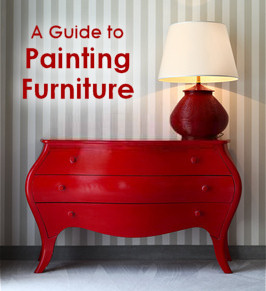DIY Guide to Painting Your Own Furniture
 Do you have some old pieces of furniture that look like they need throwing out? Do you maybe have some perfectly good pieces of furniture, such as old chairs or wall units, that are good quality, but they just don’t fit in with your current style of décor, or they just look “old fashioned” now, but again, are still too good to throw away?
Do you have some old pieces of furniture that look like they need throwing out? Do you maybe have some perfectly good pieces of furniture, such as old chairs or wall units, that are good quality, but they just don’t fit in with your current style of décor, or they just look “old fashioned” now, but again, are still too good to throw away?
This brief but informative article explains how you can rejuvenate that old furniture, and bring a new lease of life to your home, as well as the items to be painted!
Painting items of furniture is a lot different than slapping some emulsion on your walls, in fact its completely different and without thought, can lead to poor results and a general dissatisfaction of the finished article unless some steps are taken beforehand.
It is vital to make sure you know what you are doing, and you are happy to apply paint to a certain item such as wardrobe or cabinet as once it is painted, that’s it, you wont be bale to revert it back to its original state, so be sure you want to paint the item before you start.
How to paint furniture – Sand and Prime
To start with, clear an area that you can work in and around, without obstructions, and make sure the floor is covered with a sheet as you don’t want to get paint on your carpet or floor tiles.
Some furniture can be painted straight over whatever finish the item has, such as pine, or a veneer, however sometimes it is wise to sand down the item with a fine grade of sandpaper before you start, remember to thoroughly brush away any residue and dust left after sanding.
Make sure that children and pets are kept well away from the item you are painting.

Then you must apply a primer to the wood. Remember this is a primer and not an undercoat, which are 2 completely different things. The primer will, literally, prime the surface and fill in any tiny holes, so that the overall finish after the primer and top coat will be good. Priming also means that nothing that was on the item beforehand will stain or bleed through the new coat.
The primer you choose must match the type of paint you will use, for example it is prudent to use a satin, latex paint, or even an oil based paint and of course never leave the primer in its unpainted state, this is half a job and won’t do for a good finish.
Undercoat that furniture!
Then you must apply your undercoat, which should be a suitable match and complementary to the paint that you intend to finish the item off with.
When applying the undercoat it is important to get that paint into every little turn and corner to ensure a great finish when the project is complete.
If you use an oil based primer, then of course, you should use an oil based paint to cover this and continue with your project. It is also important to note at this time that if using the more durable oil based paints, they can sometimes give off a smell, so be sure to have your work area well ventilated, and carry on that ventilation whilst drying, which will speed the process up too.
Finishing off the painting project
Now you have primed and undercoated your piece of furniture and allowed to dry, the time comes for the expert bit, applying the top coat to your piece. This is the point where the most can go wrong, so pay careful attention, don’t overload your paint brush, and make sure that even before you start, you have all the tools, brushes, paints and sundry items that are needed.
It is a good tip to paint one surface, eg, the top of a table, in one go, without stopping, as if you paint one but one day, and the next but the next day, the 2 portions of painted areas may not match, and you could end up sanding it down and starting again.
Always start from the top when applying the top coat, largely because paint drips downwards, and can be easily brushed in, but if you start from the bottom, when the top is done, it will drip and ruin the work you did beneath it.
Afterwards, clean your brushes, clear the area away and allow for ventilation. The next day, you will be the proud owner of a lovely, new looking piece of furniture, at a fraction of the cost of going out and buying new!


